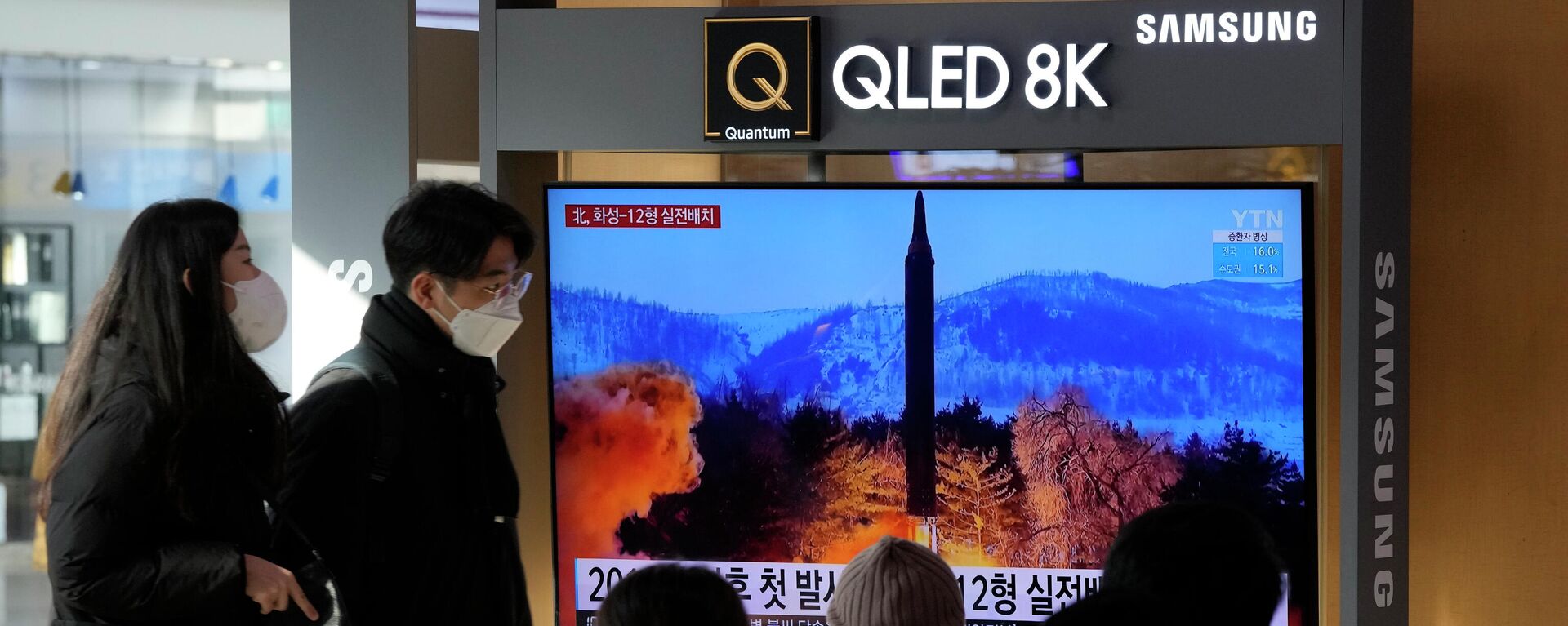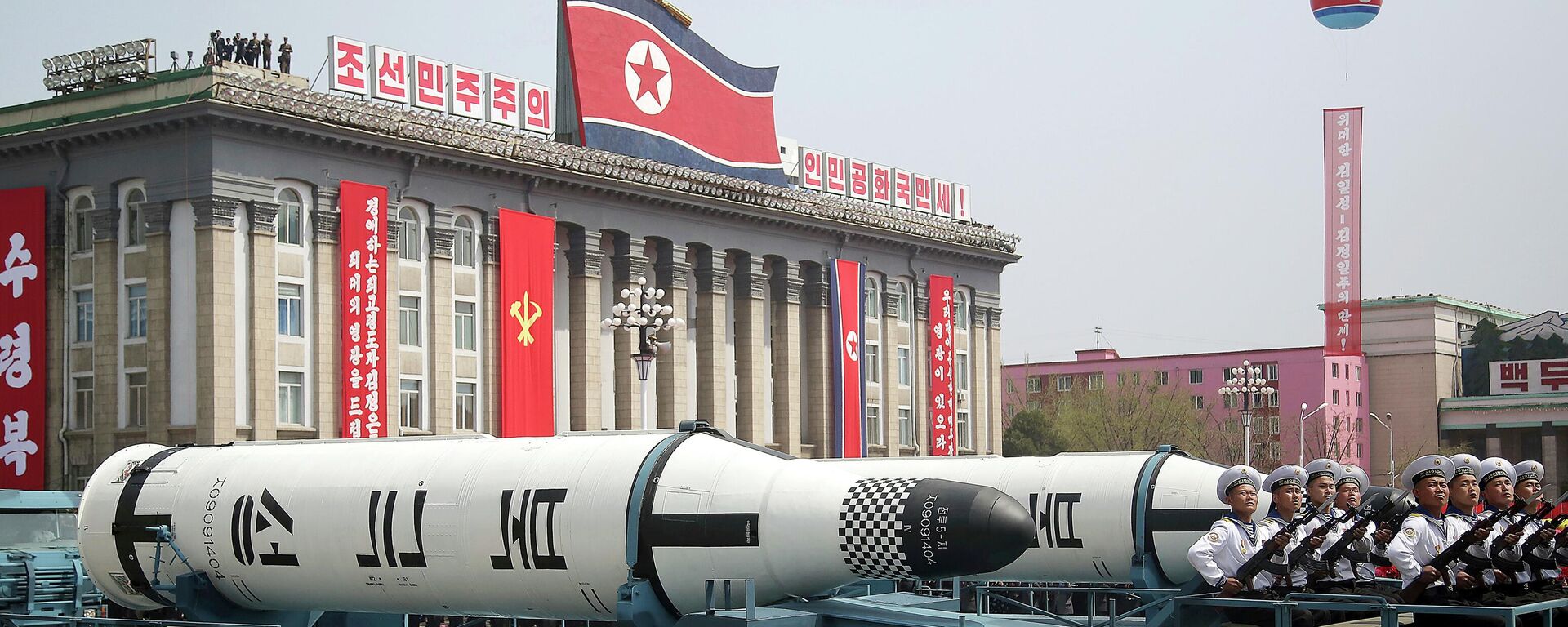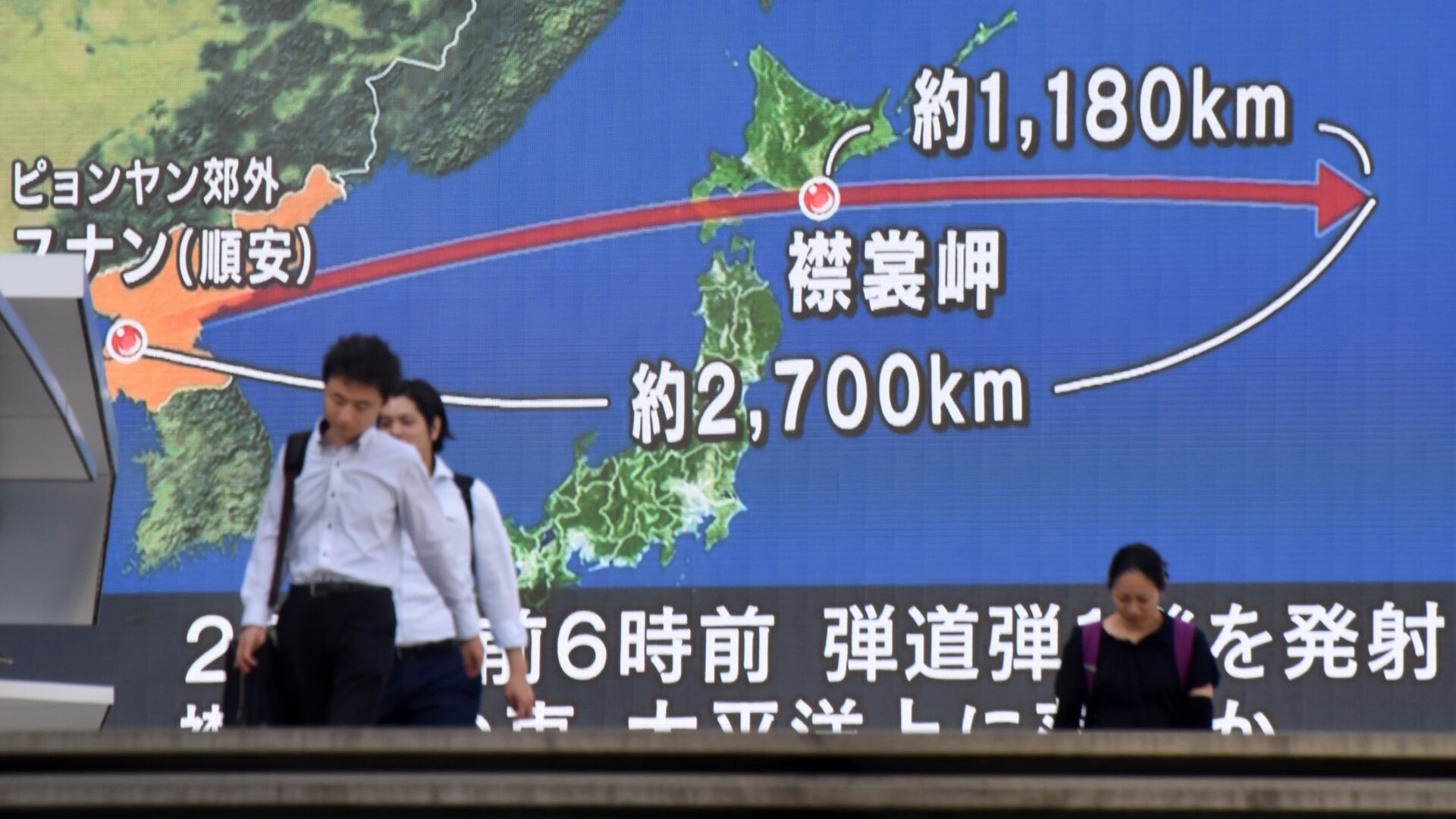https://sputnikglobe.com/20221220/whats-north-koreas-problem-with-japan-1105648380.html
What's North Korea's Problem With Japan?
What's North Korea's Problem With Japan?
Sputnik International
Japan announced a massive boost in military spending this week on a scale unseen since World War II, sparking dire warnings from Pyongyang. What’s behind North Korea’s concerns? The answers require delving into history.
2022-12-20T16:11+0000
2022-12-20T16:11+0000
2023-09-18T13:36+0000
sputnik explains
north korea
missile tests
north korea missile launch
defense strategy
strategy
japan
https://cdn1.img.sputnikglobe.com/img/105688/32/1056883217_0:183:4896:2937_1920x0_80_0_0_da3f1ac392784101183c525c783480e9.jpg
Japan announced a massive boost in military spending last week, with Tokyo’s new "National Defense Strategy" promising to more than double defense outlays over the next five years to over 43 trillion yen ($314 billion) by 2027. The spending plans will make Japan’s defense spending the third largest in the world after the United States and China, and enable the nation to match the NATO-mandated standard of spending two percent of GDP on the military.Washington immediately welcomed the new strategy, with Secretary of State Antony Blinken “congratulating” Japan and “applauding” Tokyo for its “commitment to modernize our alliance through increased investment in enhanced roles, missions and capabilities and closer defense cooperation with the United States and other allies and partners, as outlined in these new documents.”Blinken didn’t mention it, but the new spending includes billions of dollars for the purchase of US-made weapons systems, including nuclear-capable Tomahawk cruise missiles and Joint Air-to-Surface Standoff Missiles, or JASSMs. Japan’s own arms makers are expected to get a cut as well, with Mitsubishi Heavy Industry tasked with the mass manufacture of the Type-12 anti-ship guided missile, and other companies promised contracts for the creation of a stream of new arms, including hypersonic missiles and advanced drones.The new National Defense Strategy characterizes North Korea as a threat to Japan’s security interests on par with China due to Pyongyang’s ballistic missile launches “at an unprecedented high frequency” and pursuit of “further miniaturization of its nuclear weapons.”The strategy accuses North Korea of violating United Nations resolutions and of actions which “undermine” the “peace, stability and security of the region and international community.”Why Does North Korea Have a Problem With Japan?A North Korean Foreign Ministry spokesman reacted to the new Japanese defense strategy document on Tuesday, accusing Tokyo of justifying the pursuit of capabilities enabling preemptive attacks against other countries in he region, thus risking a “serious security crisis” in the Korean Peninsula and East Asia as a whole.Charging the “regime” of Prime Minister Fumio Kishida of seeking “to turn Japan into an offensive military power,” Pyongyang stressed that “the so-called ‘counterattack capability’ advocated by Japan has nothing to do with the possession of legitimate right to self-defense by a sovereign state.”The Foreign Ministry warned that Pyongyang will retain its right “to take a resolute and decisive military step to defend its national sovereignty, territorial integrity and fundamental interests in light of the complexity of the regional security environment caused by Japan’s action,” and that Tokyo will soon be made to see the error of its ways “with a shudder.”Why is There Animosity Between North Korea and Japan?Relations between the Koreas and Japan have been difficult throughout the modern era, with Korea experiencing centuries of piracy by Japanese bandits known derisively as the Wokou, or "dwarf pirates." Between 1910 and 1945, the Korean Peninsula faced direct and brutal occupation by Japan. From 1939 to 1945 alone, an estimated 60,000 Korean forced laborers died in Japan due to brutal conditions and mistreatment, with thousands more killed by the Japanese military in Korea during its anti-communist partisan insurgency operations. Thousands more Koreans were subjected to barbaric medical experiments by infamous Japanese Army groups like Unit 731. Finally, in a cruel twist of fate, some 40,000 of the estimated 215,000 people who died in the US nuclear bombings of Hiroshima and Nagasaki were Koreans.Japan’s use as an American base of operations against North Korea during the Korean War of 1950-1953 didn’t ease tensions between Pyongyang and Tokyo, with indiscriminate US bombing of North Korea from bases in Japan leveling over 85 percent of the country’s cities and towns, and killing up to 282,000 civilians.Pyongyang brought up these old wounds in the Foreign Ministry spokesman’s remarks Tuesday, calling Japan a “war criminal state” which had “inflicted untold misfortune and sufferings upon the Korean people in the past and has not yet honestly settled its past crimes.”Why are There Tensions Between North Korea and Japan Today?The answer basically comes down to two things: 1) Tokyo’s adamant refusal to admit and repent for its historical crimes against Korea, and 2) Tokyo’s status as a United States marionette and its "unsinkable aircraft carrier."In recent months, amid the total collapse of diplomacy between Pyongyang on the one side and Washington and Seoul on the other, Japan’s government added fuel to the fire by joining a series of drills with US and South Korean forces, including anti-submarine exercises, in September, drills involving a US aircraft carrier in October, and large-scale combined arms maneuvers in November.Why is North Korea Launching Missiles Over Japan?Amid rising tensions on the peninsula, North Korea has dramatically increased its nuclear-capable missile launches, conducting over 40 tests this year, ranging from short-range cruise missiles to intercontinental ballistic missiles capable of striking targets anywhere in the continental United States. Some of these missiles, including those launched in tests in October, fly close to Japanese territory, or even over the country’s northern island of Hokkaido, putting missile defense systems on alert and even triggering local air raid false alarms.North Korea’s missile tests, inextricably linked to drills by the US and its allies, are likely meant as a warning: that amid the perceived conventional superiority of the US alliance, Pyongyang has the means to retaliate to any overwhelming conventional or nuclear aggression. In its official nuclear doctrine, released in September, Pyongyang endowed itself with the right to launch its nukes “if it judges that an attack with a nuclear weapon or weapon of mass destruction was made or imminent,” or if a “fatal” conventional military attack “on important strategic objects of the state was made or imminent.”
https://sputnikglobe.com/20221124/scum-stooges--idiots-top-5-verbal-barbs-launched-by-kim-jong-uns-sisters-at-foreign-powers-1104656952.html
https://sputnikglobe.com/20221204/japan-us-mull-hypersonic-missile-defense-research-amid-chinese-north-korean-advances-1105035483.html
https://sputnikglobe.com/20221219/senior-s-korean-official-says-norths-latest-launches-aimed-at-ousting-us-military-bases-1105576115.html
https://sputnikglobe.com/20221220/kim-jong-uns-sister-says-everyone-will-soon-see-what-north-korean-missiles-can-do-1105626060.html
north korea
japan
Sputnik International
feedback@sputniknews.com
+74956456601
MIA „Rosiya Segodnya“
2022
News
en_EN
Sputnik International
feedback@sputniknews.com
+74956456601
MIA „Rosiya Segodnya“
Sputnik International
feedback@sputniknews.com
+74956456601
MIA „Rosiya Segodnya“
what's north korea's problem with japan, why is there animosity between north korea and japan, why are there tensions between north korea and japan, why is north korea launching missiles over japan, japan vs north korea who would win, how does japan feel about north korea, what is japan doing about north korea, why does north korea hate japan, how likely is north korea to attack japan, how is japan affected by the korean war, how did the korean war help japan
what's north korea's problem with japan, why is there animosity between north korea and japan, why are there tensions between north korea and japan, why is north korea launching missiles over japan, japan vs north korea who would win, how does japan feel about north korea, what is japan doing about north korea, why does north korea hate japan, how likely is north korea to attack japan, how is japan affected by the korean war, how did the korean war help japan
What's North Korea's Problem With Japan?
16:11 GMT 20.12.2022 (Updated: 13:36 GMT 18.09.2023) Already heightened tensions in Northeast Asia saw another escalation this week after Japan announced a massive boost in military spending on a scale unseen since World War II, sparking dire warnings from Pyongyang. What’s behind North Korea’s concerns, why have tensions risen, and what risks are posed? The answers require delving into history.
Japan announced a massive boost in military spending last week, with Tokyo’s new "National Defense Strategy"
promising to more than double defense outlays over the next five years to over 43 trillion yen ($314 billion) by 2027. The spending plans will make Japan’s defense spending the third largest in the world after the United States and China, and enable the nation to match the NATO-mandated standard of spending two percent of GDP on the military.
Washington
immediately welcomed the new strategy, with Secretary of State Antony Blinken “congratulating” Japan and “applauding” Tokyo for its “commitment to modernize our alliance through increased investment in enhanced roles, missions and capabilities and closer defense cooperation with the United States and other allies and partners, as outlined in these new documents.”
Blinken didn’t mention it, but the new spending includes billions of dollars for the purchase of US-made weapons systems, including nuclear-capable Tomahawk cruise missiles and Joint Air-to-Surface Standoff Missiles, or JASSMs. Japan’s own arms makers are expected to get a cut as well, with Mitsubishi Heavy Industry tasked with the mass manufacture of the Type-12 anti-ship guided missile, and other companies promised contracts for the creation of a stream of new arms, including hypersonic missiles and advanced drones.
The new National Defense Strategy characterizes North Korea as a threat to Japan’s security interests on par with China due to Pyongyang’s ballistic missile launches “at an unprecedented high frequency” and pursuit of “further miniaturization of its nuclear weapons.”
“Technologically, North Korea is considered to already have the capability to launch an attack on Japan with a ballistic missile which includes Japan in its range, fitted with a nuclear warhead. Regarding ballistic missiles…it is estimated that North Korea is rapidly improving its related technologies and operational capabilities by diversifying modes of launch. Particularly, in recent years, North Korea has been pursuing the operationalization of ballistic missiles that can fly at low altitude on irregular trajectories with the aim of making identification of signs of launch, detection and interception difficult…” the document says.
The strategy accuses North Korea of violating United Nations resolutions and of actions which “undermine” the “peace, stability and security of the region and international community.”

24 November 2022, 13:05 GMT
Why Does North Korea Have a Problem With Japan?
A North Korean Foreign Ministry spokesman reacted to the new Japanese defense strategy document on Tuesday,
accusing Tokyo of justifying the pursuit of capabilities enabling preemptive attacks against other countries in he region, thus risking a “serious security crisis” in the Korean Peninsula and East Asia as a whole.
Charging the “regime” of Prime Minister Fumio Kishida of seeking “to turn Japan into an offensive military power,” Pyongyang stressed that “the so-called ‘counterattack capability’ advocated by Japan has nothing to do with the possession of legitimate right to self-defense by a sovereign state.”
“With Japan’s formulation of its new line of aggression, the security environment in East Asia has undergone a radical change. Japan’s rearmament is a wanton violation of the UN Charter and a serious challenge to international peace and security. It should not be overlooked that the US is speaking about Japan’s greedy arms build-up in the highest terms…as a ‘bold and historic measure,’” the spokesman added.
The Foreign Ministry warned that Pyongyang will retain its right “to take a resolute and decisive military step to defend its national sovereignty, territorial integrity and fundamental interests in light of the complexity of the regional security environment caused by Japan’s action,” and that Tokyo will soon be made to see the error of its ways “with a shudder.”

4 December 2022, 17:54 GMT
Why is There Animosity Between North Korea and Japan?
Relations between the Koreas and Japan have been difficult throughout the modern era, with Korea experiencing centuries of piracy by Japanese bandits known derisively as the Wokou, or "dwarf pirates." Between 1910 and 1945, the Korean Peninsula faced direct and brutal occupation by Japan. From 1939 to 1945 alone, an estimated 60,000 Korean forced laborers died in Japan due to brutal conditions and mistreatment, with thousands more killed by the Japanese military in Korea during its anti-communist partisan insurgency operations. Thousands more Koreans were subjected to barbaric medical experiments by infamous Japanese Army groups like Unit 731. Finally, in a cruel twist of fate,
some 40,000 of the estimated 215,000 people who died in the US nuclear bombings of Hiroshima and Nagasaki were Koreans.
Japan’s use as an American base of operations against North Korea during the Korean War of 1950-1953 didn’t ease tensions between Pyongyang and Tokyo, with indiscriminate US bombing of North Korea from bases in Japan leveling over 85 percent of the country’s cities and towns, and
killing up to 282,000 civilians.Pyongyang brought up these old wounds in the Foreign Ministry spokesman’s remarks Tuesday, calling Japan a “war criminal state” which had “inflicted untold misfortune and sufferings upon the Korean people in the past and has not yet honestly settled its past crimes.”
Why are There Tensions Between North Korea and Japan Today?
The answer basically comes down to two things: 1) Tokyo’s adamant refusal to admit and repent for its historical crimes against Korea, and 2) Tokyo’s status as a United States marionette and its "unsinkable aircraft carrier."
In recent months,
amid the total collapse of diplomacy between Pyongyang on the one side and Washington and Seoul on the other, Japan’s government added fuel to the fire by joining a series of drills with US and South Korean forces,
including anti-submarine exercises, in September, drills involving a US aircraft carrier
in October, and
large-scale combined arms maneuvers in November.

19 December 2022, 05:58 GMT
Why is North Korea Launching Missiles Over Japan?
Amid rising tensions on the peninsula, North Korea has dramatically increased its nuclear-capable missile launches, conducting
over 40 tests this year, ranging from short-range cruise missiles to intercontinental ballistic missiles capable of striking targets anywhere in the continental United States. Some of these missiles, including those launched in tests in October, fly close to Japanese territory, or even over the country’s northern island of Hokkaido, putting missile defense systems on alert and
even triggering local air raid false alarms.
North Korea’s missile tests, inextricably linked to drills by the US and its allies, are likely meant as a warning: that amid the perceived conventional superiority of the US alliance, Pyongyang has the means to retaliate to any overwhelming conventional or nuclear aggression. In its official nuclear
doctrine, released in September, Pyongyang endowed itself with the right to launch its nukes “if it judges that an attack with a nuclear weapon or weapon of mass destruction was made or imminent,” or if a “fatal” conventional military attack “on important strategic objects of the state was made or imminent.”

20 December 2022, 04:37 GMT







